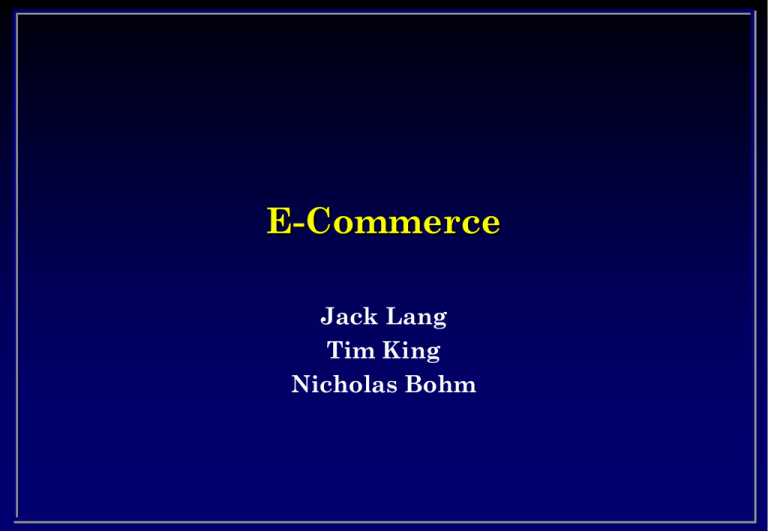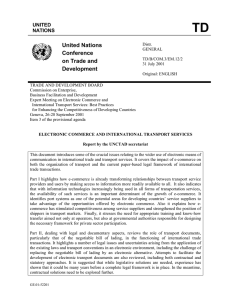E-Commerce
advertisement

E-Commerce Jack Lang Tim King Nicholas Bohm Aims Outline issues involved Lectures: – – – – – – – – Historic and Economic Background (JL) Business Models and Strategy (JL) Web Design (TJK) Implementation (TJK) The Law and E-commerce (NB) Making E-Commerce work (JL) Finance and future opportunities (JL) RIP, DCMA and other legal developments (RJA) Resources Jack Lang “High Tech Entrepreneurs Handbook” – FT.COM; ISBN: 0273656155 Ross Anderson “Security Engineering” – John Wiley & Sons Inc; ISBN: 0471389226 Hal Varian “Intermediate Microeconomics” – W.W. Norton; ISBN: 0393973700 + Carl Shapiro “Information Rules” Harvard Business School Press; ISBN: 087584863X Tom Standage “The Victorian Internet” – Orion Paperbacks; ISBN: 0753807033 John Kenneth Galbraith: A Short History of Financial Euphoria – Penguin Books; ISBN: 0140238565 Online Resources Andrew Odlyzko’s papers on e-commerce and network growth: http://www.dtc.umn.edu/~odlyzko/ Web Design: – http://www.wowwebdesigns.com – http://www.webpagesthatsuck .com Draft regulations – http://www.dti.gov.uk/cii/ecommerce/europeanpolicy /ecommerce_directive.shtml What is E-commerce? A course thought up by the Teaching committee… – Academic research on protocols, economics Mail-order (‘B2C’)…amazon.com etc New business models…Lastminute.com, ebay.com Re-badging of Electronic Document Interchange (‘EDI’) – ‘B2B’: SWIFT.CREST,BOLERO,Just-in-Time Disintermediation: E*Trade.com CRM: Call-centres, credit-cards, cost-dumping, discrimination, customer aggravation, digital “haves and have nots” EU “Information Society Services” New opportunities for fraud • This list is not exclusive! Bulla (Sumarian about 3500 BC) Business-to-business communications go back into antiquity – believed to have driven the invention of writing and mathematics – Trust system EDI (‘B2B’) Typical instruments include: – Warehouse receipts – Bills of Lading (“The holder is entitled to 100 amphorae of oil from the cargo of the ship Augusta”) – Purchase orders and invoices – Insurance certificates – Certificates of debt – Payment instructions: Bank-to-bank or bankcustomer-bank (cheques), letters of credit – Banknotes Negotiable/guaranteed – can be used for payment, security etc. Remote transaction 3. Order +LoC Customer Manufacturer 6. Bill of Lading 1. Please issue LoC: Here is deposit Shipper 2. LoC: “Pay bearer after 30 days if you have Bill of lading and Inspection Certificate 5. Bill of Lading 4. Goods 9. Goods 7. Bill of Lading Inspector Correspondent Bank Customer’s Bank Trust relationship and mutual accounts 8 Money B2B (2) The invention of the telegraph led to the development of business use protocols – Huge boom in telegraph construction and applications (Standage) – Indirect effects included creation of national markets – price differences drove rapid shipment + arbitrage – Direct uses included purchase orders and queries. Easy where there is an exisiting relationship, otherwise intermediaries needed Huge expansion in banking – Banks sent about 50% of telegraph traffic – Trusted intermediaries – Others (insurers, inspection agents, shipping agents) largely harnessed via bank mechanisms B2B 3- Wiring Money Interbank message e.g – “To: Lomarco Bank, Geneva. Please pay SFR 10,000 from our account to Herr Thilo Schmidt on presentation of his passport. Our test key is 254” – The 254 is a primitive MAC computed on significant data such as money, currency code, date etc. SWIFT reimplement this using ‘email’ and proper MAC in mid 70’s. – First big ‘open’ EDI system – Swift II added PKI to manage MAC keys in early 1990’s. – Adapted to CREST (UK equity clearing) Commercial transactions similar, but more complex conditions – E.g LoC needs Bill of Lading, insurance certificate and inspection certificate B2B 4 “Electronic Document Interchange” (EDI) – Proprietary systems built late 60’s/early 70’s • General Motors ordering car components (EDS) • Marks & Spencer’s clothes ordering Big problem not security or DoS or lost systems but standards – 1980’s agreeing common message formats • UN, specific country/industry e.g NHS – Being redone as XML • e.g BOLERO (www.bolero.net) – Many players – slow progress B2C Mail Order Book printers in C15th – Aldus Manutius of Venice 1498. His mail-order offerings included 15 texts that he had published. (UK version) William Lucus, Gardener, 1667 – Army and Navy Stores supplied British Forces and others in India ~1871 (US Version) Tiffany of Fifth Ave 1845 – Montgomery Ward 1872 Sears, Roebuck made it possible to settle the West(1886) – US Postal services subsidised shipping by having flat rates nationwide. • Still critical in some places! Need guarantee to provide customer confidence – Brand (e.g Sears, Amazon…) • Sears unique innovation: “Satisfaction guaranteed or your money back” – Industry (ABTA, MOPS) – Intermediary (VISA, Access etc) Credit Cards Consumer credit goes back to 18th Century – “The Tallyman” – Some US stores offer “shopper's plate” from 1920’s Diners Club offered first credit card – NY 1951: 27 Restaurants, 200 customers Barclaycard offered as incentive to high-value Barclays customers in late 60s; Access started as rival Classic “Network effect” – Need enough shops to attract customers and vice versa Took off in early 1980’s suddenly turning from loss leader to main profit centre. – Some countries (e.g. Germany, Japan) only just taking off Earnings from online trades starting to be significant – Competition starting e.g Paypal Credit Cards 2 Brand e.g. VISA Issuer Acquirer e.g. Bank Merchant Credit Cards 3 Merchant is paid for goods by acquiring bank, less merchant discount (typically 210%, often 4-5%) Transactions over floor limit checked with acquirer: hot card list or credit check with issuer Brand takes a cut; acquirer makes money from merchant discount; issuer from selling revolving credit - expensive money, often over 20% APR Credit Cards 4 Originally fraud risk borne by banks Introduction of mail order and telephone (and web) order (MOTO) risk for transactions with the cardholder not present passed to merchant. MOTO have lower floor limits, and in delivery only to cardholder address (but not possible to be checked for e-delivery or services like Worldpay) – 40% fraud fro some sites – Paypal fraud Traditional frauds: – Stolen cards – Pre-issue – Identity theft Cards 5 Evolution of forgery Attack Simple copy Countermeasure Hologram Alter embossing Check mag strip Emboss mag strip # TDC Make up strip CVV, CVC Skimming Intrusion detection Free Lunch Cards 6 Overall cost of fraud – Spain 0.01% – UK 0.2% – USA 1.0% Motivation – who gets the reward? – Huge hyoe “Evil Hackers” – No case of fraud resulting from interception! • Getting sense from mail is hard – Real problem: hacked or crooked end systems Overall pattern – cyclical: Best defences not always high-tech! Cards 7 Bigger problem: disputes – Porn sites – Paypal etc Incompetence, fraudulent denial by customers, outright fraud by merchants Control mechanisms poor and slow – e.g acquirer call centre can only check country, not cardholder address Technology? – SET failed – Other formats, e.g stored value cards, cell-phones PKI Hyped technology – Verisign, Baltimore had 11 figure market caps – Sanity returns… Closed PKI, such as SWIFT or corporate network make sense (and ship with W2K) Open PKI (everyone has a certificate) less successful – Masquerade not a real issue – Who is Certification Authority? • Why should Verisign certify Foo com is Foo Inc? • “Let a thousand CA’s bloom” – Or why should your bank warrant your identity for a drivers licence? PKI 2 TSL (was SSL) – Used for every secure web-page – Certificate exchange -> session key – It’s the ends that leak: Transmission has “adequate” security • “Moving information by armoured truck from one cardboard box to another” • No known instance of commercial eavesdropping Anonymous money – Chaum: e-cash – Hettinga: Internet Bearer Underwriter Corp • More theoretical than practical – Stored value cards • HK Octopus PKI 3 Hot topics: – Who controls your identity? • Government, Bank, or Microsoft? – Identity cards, MS .Net Lots of issues: – liability, control, civil liberties, protocol attacks, etc






